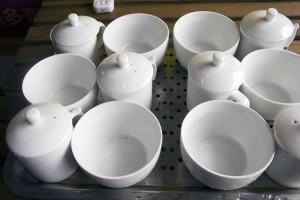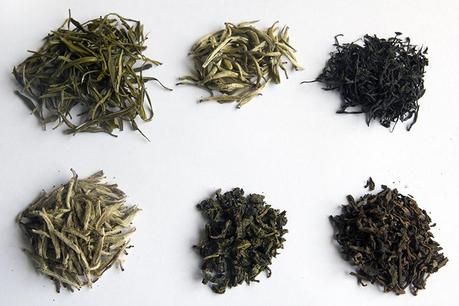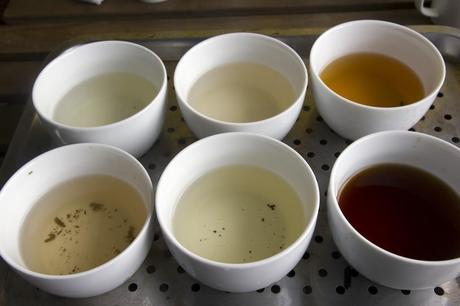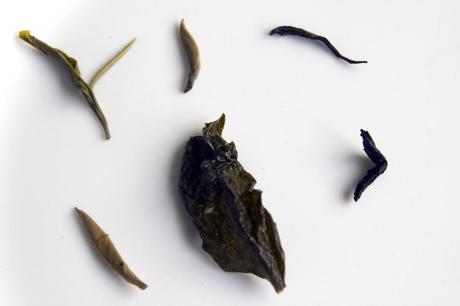One of the most common and useful ways of approaching our study of tea is by segmenting them into categories based on their method of production.
The method of production allows us to classify every kind of tea into 1 of the following 6 major categories: green, white, yellow, oolong, black and dark aka post-fermented teas.
In most courses or workshops that provide an overview of tea- including ours- the structure is organized based on these categories. Although it must be said some institutions especially outside of China lack a proper understanding of the categories, often providing 4 or misclassifying them.
This post, we won’t tackle anything so ambitious, just providing a visual comparison.
Methodology
3 grams of each tea was weighed out.
The varieties of teas used for each category are:

White Tea: Silver Needles
Yellow Tea: Huoshan Huangya
Oolong Tea: Anxi Tieguanyin
Black Tea: Qimen Black
Dark Tea: Ripe Puer
To provide a proper basis of comparison, the teas are brewed using the exact same method.
If we are brewing this for consumption, obviously it would be ‘wrong’ but since this is for illustrative purposes, as any science student would know, all variables are held constant except the one we are comparing against.
Hence, we use our trusty taster mugs- not always the best for extracted the full flavor but good for comparative tasting because of its simplicity.
Each mug is 150 ml and hence the ratio is 1 g for every 50 ml of water.
Water at 95⁰C is used and infusion time is set at 2 minutes.
In practice, as we poured using a plain old kettle, water is not poured exactly at the same time.
When measured, it took each pour took about 5 seconds and hence we extended 5 seconds when decanting the tea to equalize it.
Dry Leaves

Clockwise from Top Left Corner:
Huangshan Maofeng, Huoshan Huangya, Qimen Black, Ripe Puer, Anxi Tieguanyin, Silver Needles
As you can see from the photo, the volume of tea varies quite a fair bit for the different teas.
The Huangshan Maofeng is ‘fluffier’ than most other teas while the Tieguanyin due to its tightly rolled appearance is very ‘dense’.
Looking at this, it becomes clear that the oft repeated ‘golden rule’ of 1 spoon for each person and 1 for the pot can’t possibly apply to all types of teas.
That aside, the color also gives us some clues on the processing but this is more apparent in the wet leaves.
Liquor

Clockwise from Top Left Corner:
Huangshan Maofeng, Huoshan Huangya, Qimen Black, Ripe Puer, Anxi Tieguanyin, Silver Needles
Green tea: Pale greenish yellow
Yellow tea: Yellow
Black tea: Reddish
Dark tea: Black
Oolong tea: darker greenish yellow
White tea: Almond yellow
Wet Leaves

Clockwise from Top Left Corner:
Huangshan Maofeng, Huoshan Huangya, Qimen Black, Ripe Puer, Anxi Tieguanyin, Silver Needles
From the wet leaves you can understand the key production process better:
Green tea leaf is the most green (duh). This is due to the heating or “shaqing” process taking place from the onset preventing oxidation.
White tea leaves are darker as there is some natural oxidation that takes place during withering and drying (sunning or baking) doesn’t stop the oxidation completely.
Yellow tea leaves are yellow (duh) because of the ‘men huang’ (stewing) stage that leads to the liquor and leaves being yellowed due to heat and humidity.
Oolong tea leaves are partially oxidized due to the ‘yaoqing’ or rattling stage that expedites the oxidation.
Black tea leaves are red- in fact black tea is known as hongcha or red tea in Chinese- due to the oxidation of polyphenols to thearubigins and theaflavins that are reddish in color.
The dark tea leaves are black- in fact dark tea is heicha or black tea in Chinese- due to the actual fermentation that takes place. That’s why the leaves look shriveled.
This topic is of course bigger than this post but hope the visual differences pique your interest to study the different categories of tea.
Please click to see other articles related to brewing tea.
